Global Business Issue: Coca-Cola Acquisition of Costa Coffee
VerifiedAdded on 2022/10/12
|7
|1448
|107
Report
AI Summary
This report examines Coca-Cola's acquisition of Costa Coffee, a significant global business move. It analyzes the acquisition's implications using PESTLE analysis, Porter's Five Forces, and the Ansoff Matrix. The report explores the political, economic, social, technological, environmental, and legal factors influencing the acquisition. It assesses competitive forces, including the threat of entrants, barriers to entry, competitive rivalry, and the power of buyers and suppliers. Furthermore, it applies the Ansoff Matrix to evaluate market penetration, product development, market development, and diversification strategies. The analysis highlights Coca-Cola's strategic goals to capitalize on the growing coffee market and gain a competitive advantage. This report provides a comprehensive overview of the acquisition's impact and strategic significance in the global beverage market.
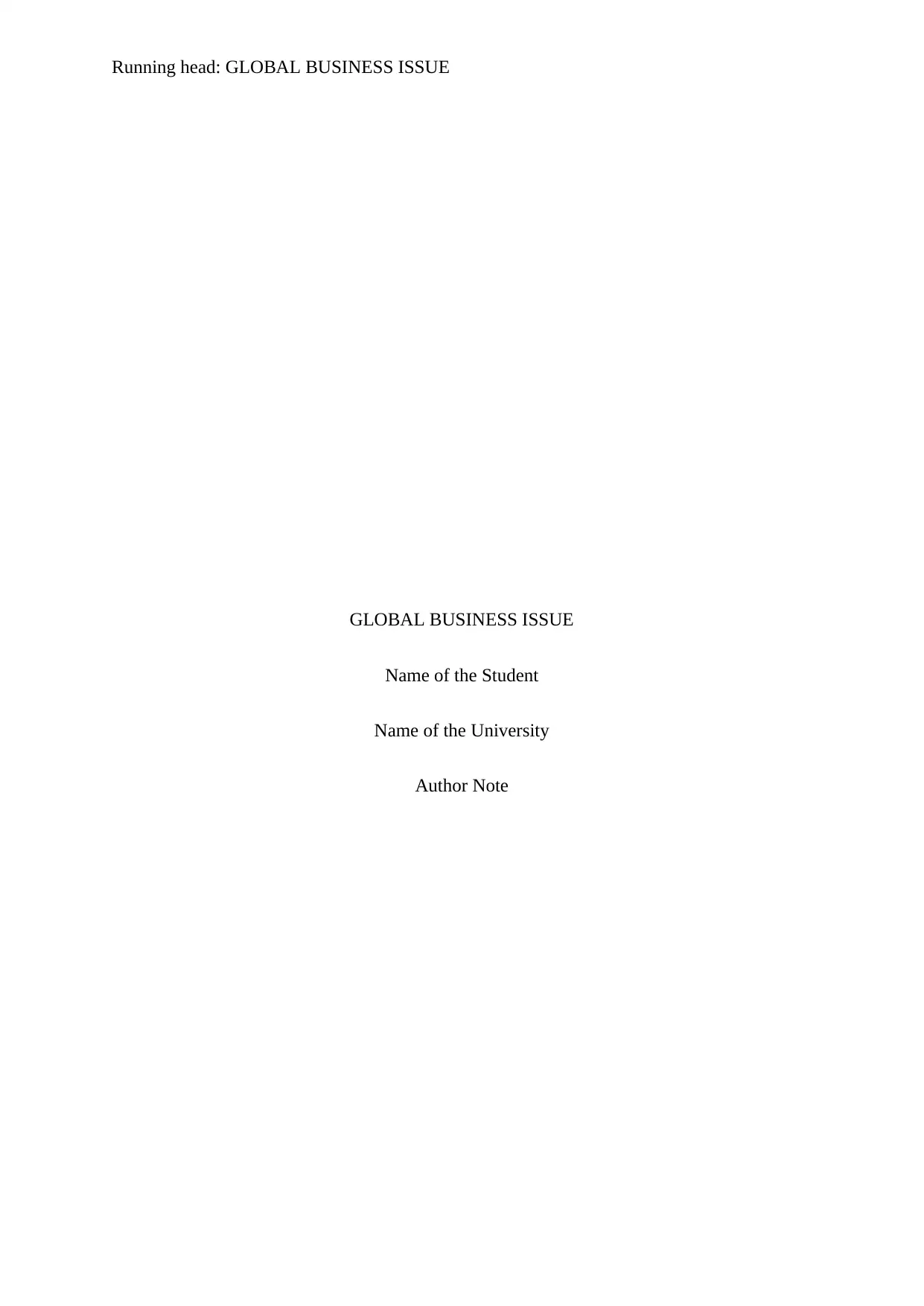
Running head: GLOBAL BUSINESS ISSUE
GLOBAL BUSINESS ISSUE
Name of the Student
Name of the University
Author Note
GLOBAL BUSINESS ISSUE
Name of the Student
Name of the University
Author Note
Paraphrase This Document
Need a fresh take? Get an instant paraphrase of this document with our AI Paraphraser
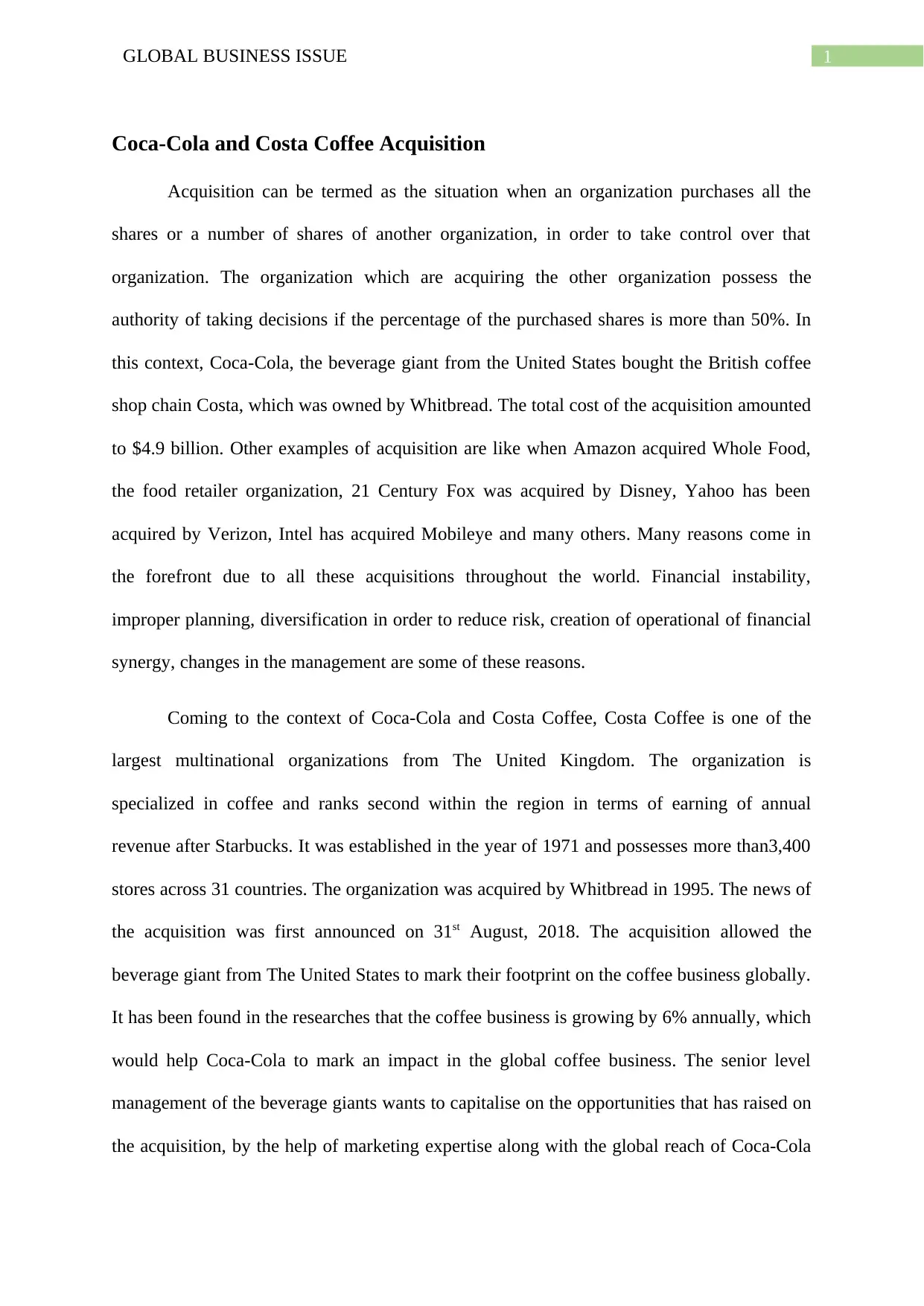
1GLOBAL BUSINESS ISSUE
Coca-Cola and Costa Coffee Acquisition
Acquisition can be termed as the situation when an organization purchases all the
shares or a number of shares of another organization, in order to take control over that
organization. The organization which are acquiring the other organization possess the
authority of taking decisions if the percentage of the purchased shares is more than 50%. In
this context, Coca-Cola, the beverage giant from the United States bought the British coffee
shop chain Costa, which was owned by Whitbread. The total cost of the acquisition amounted
to $4.9 billion. Other examples of acquisition are like when Amazon acquired Whole Food,
the food retailer organization, 21 Century Fox was acquired by Disney, Yahoo has been
acquired by Verizon, Intel has acquired Mobileye and many others. Many reasons come in
the forefront due to all these acquisitions throughout the world. Financial instability,
improper planning, diversification in order to reduce risk, creation of operational of financial
synergy, changes in the management are some of these reasons.
Coming to the context of Coca-Cola and Costa Coffee, Costa Coffee is one of the
largest multinational organizations from The United Kingdom. The organization is
specialized in coffee and ranks second within the region in terms of earning of annual
revenue after Starbucks. It was established in the year of 1971 and possesses more than3,400
stores across 31 countries. The organization was acquired by Whitbread in 1995. The news of
the acquisition was first announced on 31st August, 2018. The acquisition allowed the
beverage giant from The United States to mark their footprint on the coffee business globally.
It has been found in the researches that the coffee business is growing by 6% annually, which
would help Coca-Cola to mark an impact in the global coffee business. The senior level
management of the beverage giants wants to capitalise on the opportunities that has raised on
the acquisition, by the help of marketing expertise along with the global reach of Coca-Cola
Coca-Cola and Costa Coffee Acquisition
Acquisition can be termed as the situation when an organization purchases all the
shares or a number of shares of another organization, in order to take control over that
organization. The organization which are acquiring the other organization possess the
authority of taking decisions if the percentage of the purchased shares is more than 50%. In
this context, Coca-Cola, the beverage giant from the United States bought the British coffee
shop chain Costa, which was owned by Whitbread. The total cost of the acquisition amounted
to $4.9 billion. Other examples of acquisition are like when Amazon acquired Whole Food,
the food retailer organization, 21 Century Fox was acquired by Disney, Yahoo has been
acquired by Verizon, Intel has acquired Mobileye and many others. Many reasons come in
the forefront due to all these acquisitions throughout the world. Financial instability,
improper planning, diversification in order to reduce risk, creation of operational of financial
synergy, changes in the management are some of these reasons.
Coming to the context of Coca-Cola and Costa Coffee, Costa Coffee is one of the
largest multinational organizations from The United Kingdom. The organization is
specialized in coffee and ranks second within the region in terms of earning of annual
revenue after Starbucks. It was established in the year of 1971 and possesses more than3,400
stores across 31 countries. The organization was acquired by Whitbread in 1995. The news of
the acquisition was first announced on 31st August, 2018. The acquisition allowed the
beverage giant from The United States to mark their footprint on the coffee business globally.
It has been found in the researches that the coffee business is growing by 6% annually, which
would help Coca-Cola to mark an impact in the global coffee business. The senior level
management of the beverage giants wants to capitalise on the opportunities that has raised on
the acquisition, by the help of marketing expertise along with the global reach of Coca-Cola
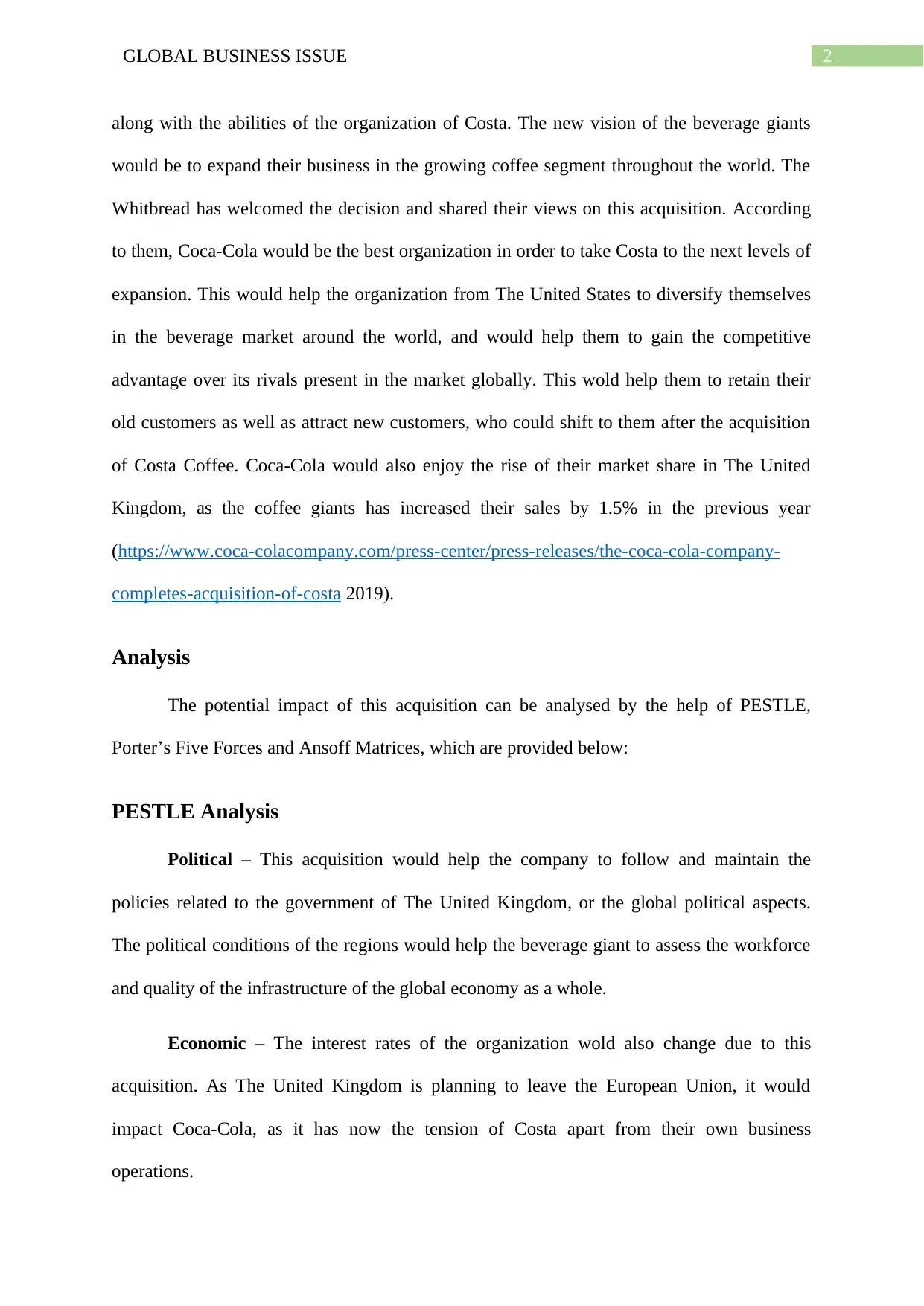
2GLOBAL BUSINESS ISSUE
along with the abilities of the organization of Costa. The new vision of the beverage giants
would be to expand their business in the growing coffee segment throughout the world. The
Whitbread has welcomed the decision and shared their views on this acquisition. According
to them, Coca-Cola would be the best organization in order to take Costa to the next levels of
expansion. This would help the organization from The United States to diversify themselves
in the beverage market around the world, and would help them to gain the competitive
advantage over its rivals present in the market globally. This wold help them to retain their
old customers as well as attract new customers, who could shift to them after the acquisition
of Costa Coffee. Coca-Cola would also enjoy the rise of their market share in The United
Kingdom, as the coffee giants has increased their sales by 1.5% in the previous year
(https://www.coca-colacompany.com/press-center/press-releases/the-coca-cola-company-
completes-acquisition-of-costa 2019).
Analysis
The potential impact of this acquisition can be analysed by the help of PESTLE,
Porter’s Five Forces and Ansoff Matrices, which are provided below:
PESTLE Analysis
Political – This acquisition would help the company to follow and maintain the
policies related to the government of The United Kingdom, or the global political aspects.
The political conditions of the regions would help the beverage giant to assess the workforce
and quality of the infrastructure of the global economy as a whole.
Economic – The interest rates of the organization wold also change due to this
acquisition. As The United Kingdom is planning to leave the European Union, it would
impact Coca-Cola, as it has now the tension of Costa apart from their own business
operations.
along with the abilities of the organization of Costa. The new vision of the beverage giants
would be to expand their business in the growing coffee segment throughout the world. The
Whitbread has welcomed the decision and shared their views on this acquisition. According
to them, Coca-Cola would be the best organization in order to take Costa to the next levels of
expansion. This would help the organization from The United States to diversify themselves
in the beverage market around the world, and would help them to gain the competitive
advantage over its rivals present in the market globally. This wold help them to retain their
old customers as well as attract new customers, who could shift to them after the acquisition
of Costa Coffee. Coca-Cola would also enjoy the rise of their market share in The United
Kingdom, as the coffee giants has increased their sales by 1.5% in the previous year
(https://www.coca-colacompany.com/press-center/press-releases/the-coca-cola-company-
completes-acquisition-of-costa 2019).
Analysis
The potential impact of this acquisition can be analysed by the help of PESTLE,
Porter’s Five Forces and Ansoff Matrices, which are provided below:
PESTLE Analysis
Political – This acquisition would help the company to follow and maintain the
policies related to the government of The United Kingdom, or the global political aspects.
The political conditions of the regions would help the beverage giant to assess the workforce
and quality of the infrastructure of the global economy as a whole.
Economic – The interest rates of the organization wold also change due to this
acquisition. As The United Kingdom is planning to leave the European Union, it would
impact Coca-Cola, as it has now the tension of Costa apart from their own business
operations.
⊘ This is a preview!⊘
Do you want full access?
Subscribe today to unlock all pages.

Trusted by 1+ million students worldwide
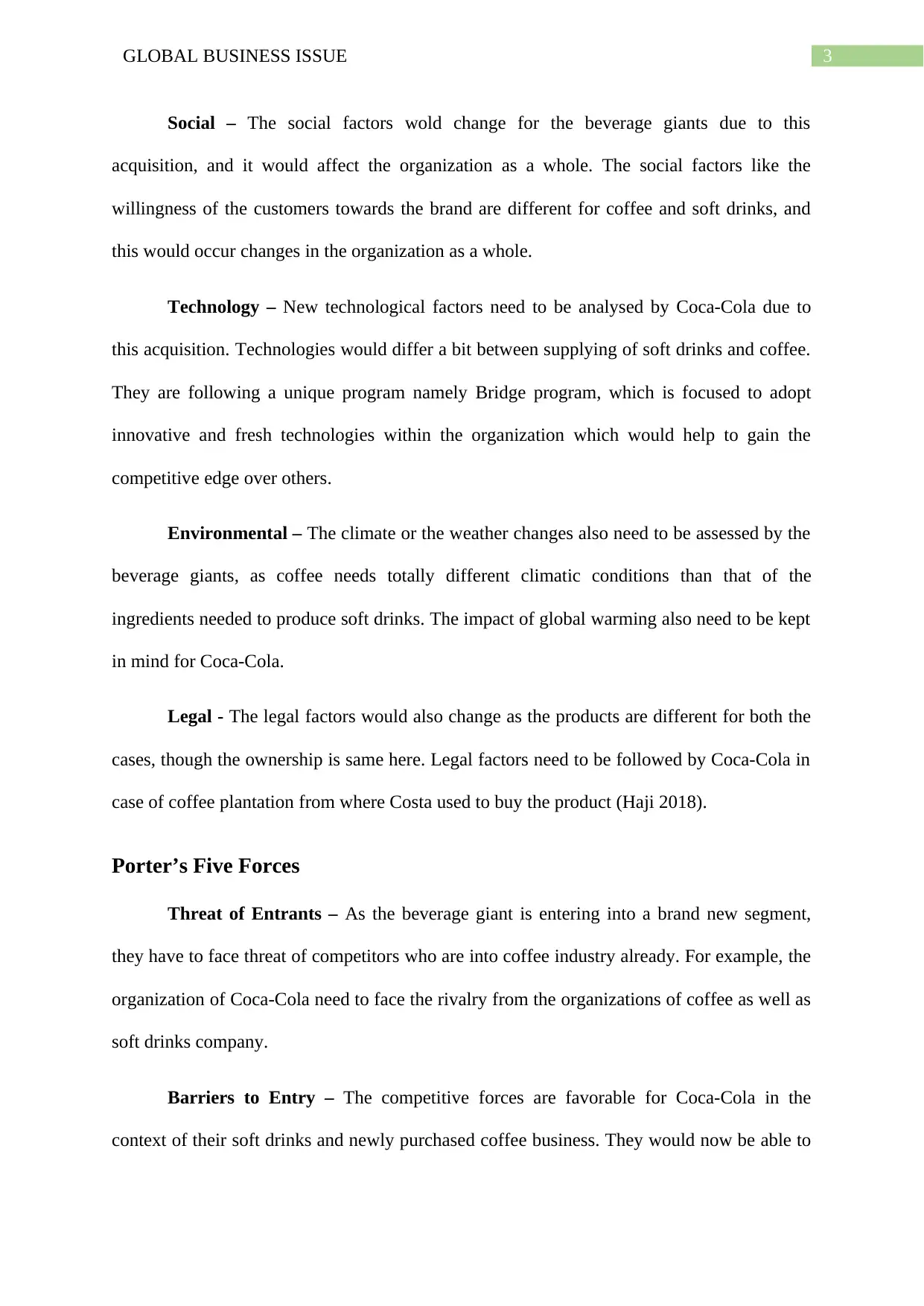
3GLOBAL BUSINESS ISSUE
Social – The social factors wold change for the beverage giants due to this
acquisition, and it would affect the organization as a whole. The social factors like the
willingness of the customers towards the brand are different for coffee and soft drinks, and
this would occur changes in the organization as a whole.
Technology – New technological factors need to be analysed by Coca-Cola due to
this acquisition. Technologies would differ a bit between supplying of soft drinks and coffee.
They are following a unique program namely Bridge program, which is focused to adopt
innovative and fresh technologies within the organization which would help to gain the
competitive edge over others.
Environmental – The climate or the weather changes also need to be assessed by the
beverage giants, as coffee needs totally different climatic conditions than that of the
ingredients needed to produce soft drinks. The impact of global warming also need to be kept
in mind for Coca-Cola.
Legal - The legal factors would also change as the products are different for both the
cases, though the ownership is same here. Legal factors need to be followed by Coca-Cola in
case of coffee plantation from where Costa used to buy the product (Haji 2018).
Porter’s Five Forces
Threat of Entrants – As the beverage giant is entering into a brand new segment,
they have to face threat of competitors who are into coffee industry already. For example, the
organization of Coca-Cola need to face the rivalry from the organizations of coffee as well as
soft drinks company.
Barriers to Entry – The competitive forces are favorable for Coca-Cola in the
context of their soft drinks and newly purchased coffee business. They would now be able to
Social – The social factors wold change for the beverage giants due to this
acquisition, and it would affect the organization as a whole. The social factors like the
willingness of the customers towards the brand are different for coffee and soft drinks, and
this would occur changes in the organization as a whole.
Technology – New technological factors need to be analysed by Coca-Cola due to
this acquisition. Technologies would differ a bit between supplying of soft drinks and coffee.
They are following a unique program namely Bridge program, which is focused to adopt
innovative and fresh technologies within the organization which would help to gain the
competitive edge over others.
Environmental – The climate or the weather changes also need to be assessed by the
beverage giants, as coffee needs totally different climatic conditions than that of the
ingredients needed to produce soft drinks. The impact of global warming also need to be kept
in mind for Coca-Cola.
Legal - The legal factors would also change as the products are different for both the
cases, though the ownership is same here. Legal factors need to be followed by Coca-Cola in
case of coffee plantation from where Costa used to buy the product (Haji 2018).
Porter’s Five Forces
Threat of Entrants – As the beverage giant is entering into a brand new segment,
they have to face threat of competitors who are into coffee industry already. For example, the
organization of Coca-Cola need to face the rivalry from the organizations of coffee as well as
soft drinks company.
Barriers to Entry – The competitive forces are favorable for Coca-Cola in the
context of their soft drinks and newly purchased coffee business. They would now be able to
Paraphrase This Document
Need a fresh take? Get an instant paraphrase of this document with our AI Paraphraser
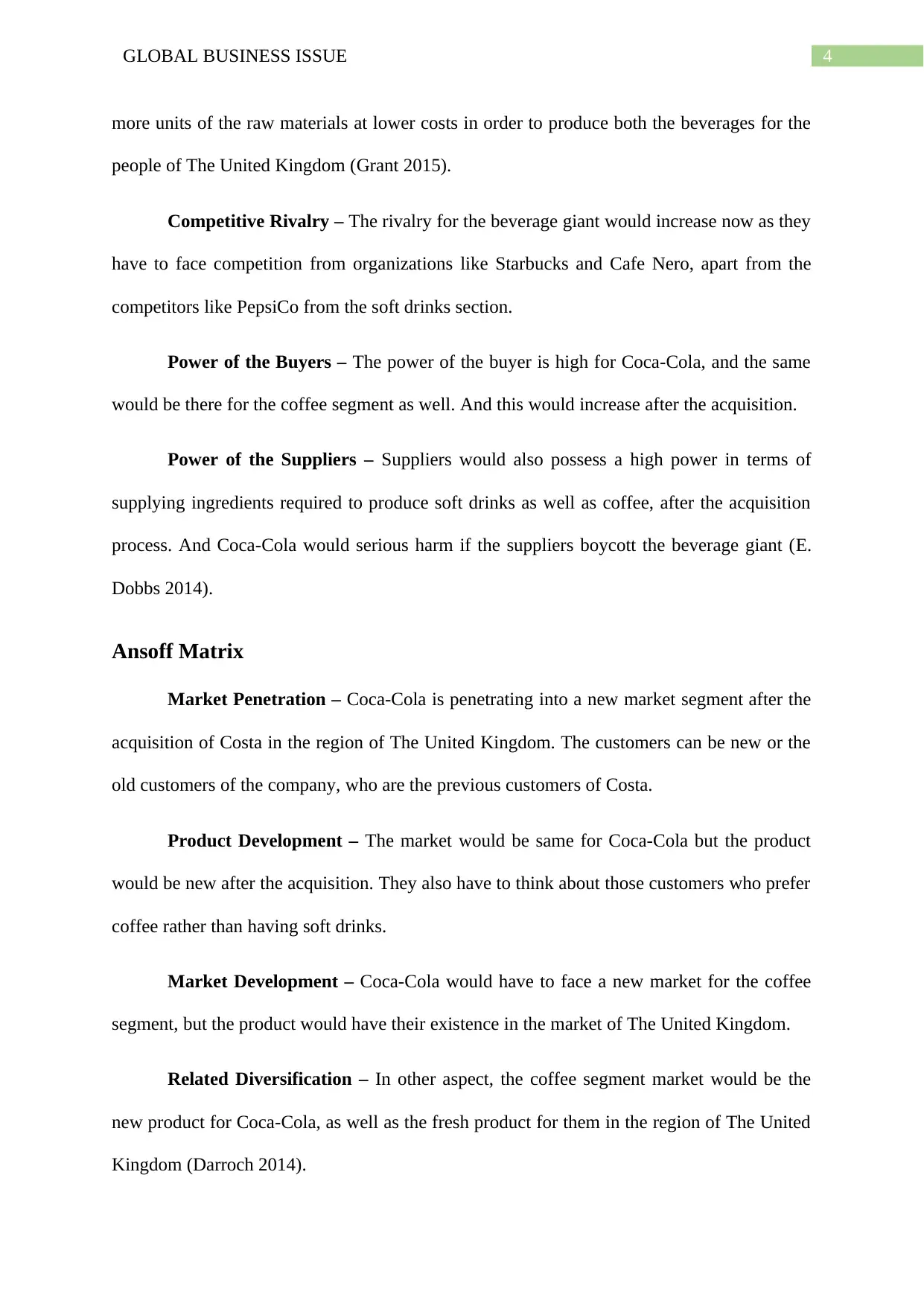
4GLOBAL BUSINESS ISSUE
more units of the raw materials at lower costs in order to produce both the beverages for the
people of The United Kingdom (Grant 2015).
Competitive Rivalry – The rivalry for the beverage giant would increase now as they
have to face competition from organizations like Starbucks and Cafe Nero, apart from the
competitors like PepsiCo from the soft drinks section.
Power of the Buyers – The power of the buyer is high for Coca-Cola, and the same
would be there for the coffee segment as well. And this would increase after the acquisition.
Power of the Suppliers – Suppliers would also possess a high power in terms of
supplying ingredients required to produce soft drinks as well as coffee, after the acquisition
process. And Coca-Cola would serious harm if the suppliers boycott the beverage giant (E.
Dobbs 2014).
Ansoff Matrix
Market Penetration – Coca-Cola is penetrating into a new market segment after the
acquisition of Costa in the region of The United Kingdom. The customers can be new or the
old customers of the company, who are the previous customers of Costa.
Product Development – The market would be same for Coca-Cola but the product
would be new after the acquisition. They also have to think about those customers who prefer
coffee rather than having soft drinks.
Market Development – Coca-Cola would have to face a new market for the coffee
segment, but the product would have their existence in the market of The United Kingdom.
Related Diversification – In other aspect, the coffee segment market would be the
new product for Coca-Cola, as well as the fresh product for them in the region of The United
Kingdom (Darroch 2014).
more units of the raw materials at lower costs in order to produce both the beverages for the
people of The United Kingdom (Grant 2015).
Competitive Rivalry – The rivalry for the beverage giant would increase now as they
have to face competition from organizations like Starbucks and Cafe Nero, apart from the
competitors like PepsiCo from the soft drinks section.
Power of the Buyers – The power of the buyer is high for Coca-Cola, and the same
would be there for the coffee segment as well. And this would increase after the acquisition.
Power of the Suppliers – Suppliers would also possess a high power in terms of
supplying ingredients required to produce soft drinks as well as coffee, after the acquisition
process. And Coca-Cola would serious harm if the suppliers boycott the beverage giant (E.
Dobbs 2014).
Ansoff Matrix
Market Penetration – Coca-Cola is penetrating into a new market segment after the
acquisition of Costa in the region of The United Kingdom. The customers can be new or the
old customers of the company, who are the previous customers of Costa.
Product Development – The market would be same for Coca-Cola but the product
would be new after the acquisition. They also have to think about those customers who prefer
coffee rather than having soft drinks.
Market Development – Coca-Cola would have to face a new market for the coffee
segment, but the product would have their existence in the market of The United Kingdom.
Related Diversification – In other aspect, the coffee segment market would be the
new product for Coca-Cola, as well as the fresh product for them in the region of The United
Kingdom (Darroch 2014).

5GLOBAL BUSINESS ISSUE
⊘ This is a preview!⊘
Do you want full access?
Subscribe today to unlock all pages.

Trusted by 1+ million students worldwide
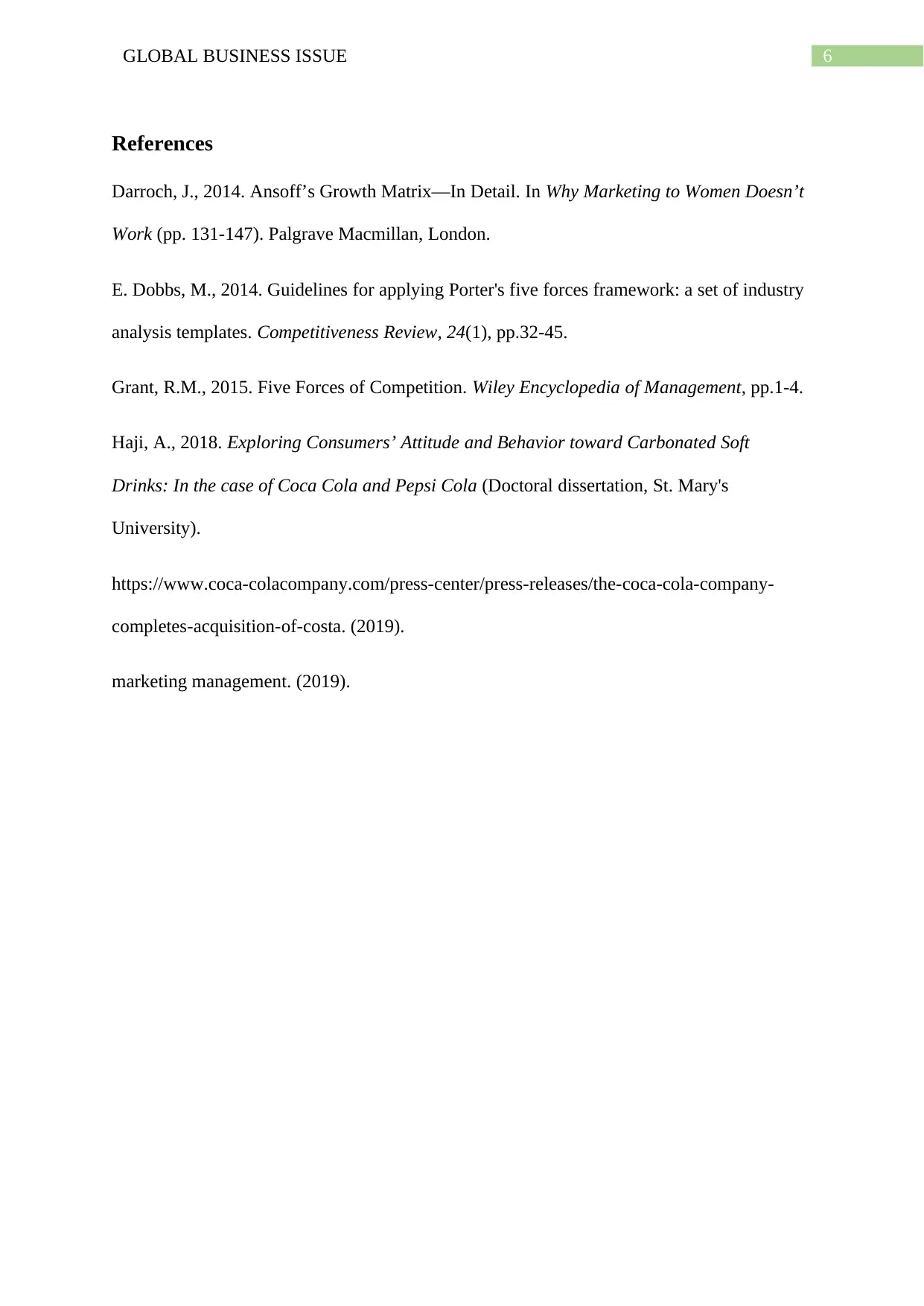
6GLOBAL BUSINESS ISSUE
References
Darroch, J., 2014. Ansoff’s Growth Matrix—In Detail. In Why Marketing to Women Doesn’t
Work (pp. 131-147). Palgrave Macmillan, London.
E. Dobbs, M., 2014. Guidelines for applying Porter's five forces framework: a set of industry
analysis templates. Competitiveness Review, 24(1), pp.32-45.
Grant, R.M., 2015. Five Forces of Competition. Wiley Encyclopedia of Management, pp.1-4.
Haji, A., 2018. Exploring Consumers’ Attitude and Behavior toward Carbonated Soft
Drinks: In the case of Coca Cola and Pepsi Cola (Doctoral dissertation, St. Mary's
University).
https://www.coca-colacompany.com/press-center/press-releases/the-coca-cola-company-
completes-acquisition-of-costa. (2019).
marketing management. (2019).
References
Darroch, J., 2014. Ansoff’s Growth Matrix—In Detail. In Why Marketing to Women Doesn’t
Work (pp. 131-147). Palgrave Macmillan, London.
E. Dobbs, M., 2014. Guidelines for applying Porter's five forces framework: a set of industry
analysis templates. Competitiveness Review, 24(1), pp.32-45.
Grant, R.M., 2015. Five Forces of Competition. Wiley Encyclopedia of Management, pp.1-4.
Haji, A., 2018. Exploring Consumers’ Attitude and Behavior toward Carbonated Soft
Drinks: In the case of Coca Cola and Pepsi Cola (Doctoral dissertation, St. Mary's
University).
https://www.coca-colacompany.com/press-center/press-releases/the-coca-cola-company-
completes-acquisition-of-costa. (2019).
marketing management. (2019).
1 out of 7
Related Documents
Your All-in-One AI-Powered Toolkit for Academic Success.
+13062052269
info@desklib.com
Available 24*7 on WhatsApp / Email
![[object Object]](/_next/static/media/star-bottom.7253800d.svg)
Unlock your academic potential
Copyright © 2020–2025 A2Z Services. All Rights Reserved. Developed and managed by ZUCOL.




